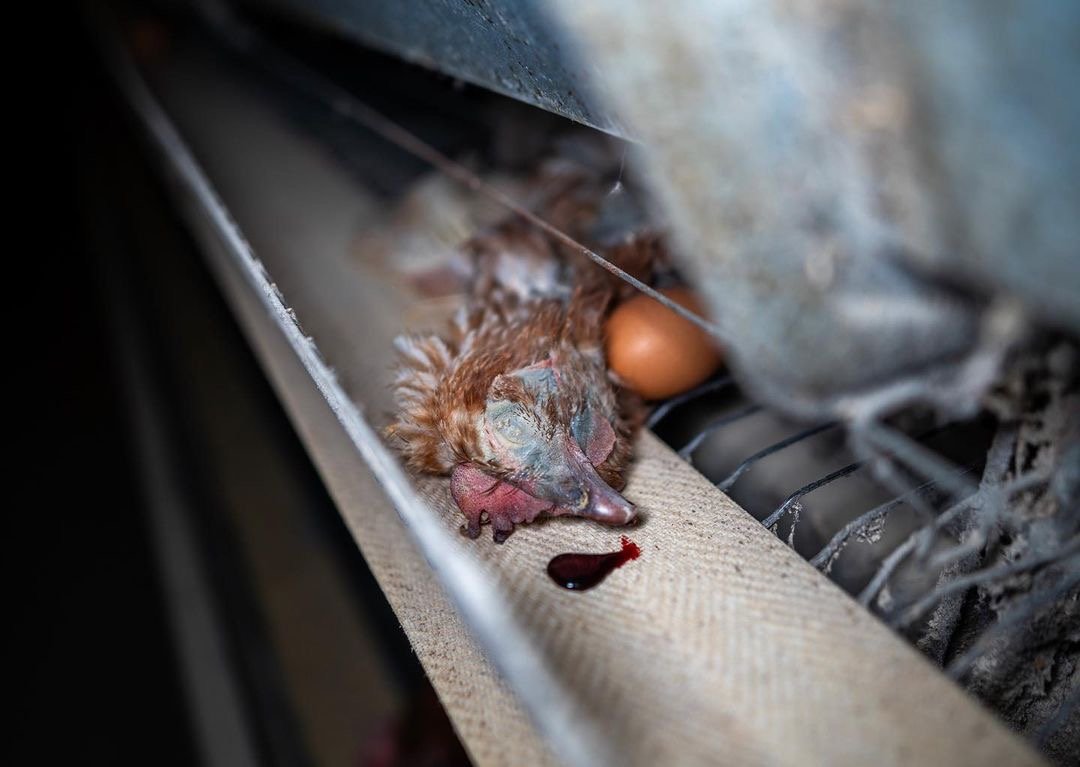Scrambling for Solutions: Ethical Choices for Easter Eggs
Modified image depicting a hen in a battery cage, sourced from an Andrew Skowron photograph.
Easter embodies hope and new beginnings; except, that is, for the billions of lives whose exploitation is the basis of an increasingly popular and thoroughly unsustainable seasonal celebration.
For many, painting, hiding, and finding eggs are family traditions soaked in childhood memories, a celebration of life's triumphs and the promise of brighter days ahead. Innocent and fashionable activities popularized by international media. However, beneath the surface of painted eggs and joyful hunts lies the harsh reality of layer hens' suffering. There is no renewal or rebirth for them. Rather, and as we have shown time and again, their existence under the egg industry is one of perpetual confinement, pain, and premature death; a life of unimaginable hardships deprived of basic freedoms, and subjected to relentless exploitation.
The Story Behind Egg Coloring and Its Ethical Implications
The practice of coloring and decorating eggs has a rich and diverse history that spans centuries and cultures. It is believed to have originated from ancient pagan rituals celebrating the arrival of spring and the resurgence of life in nature. Eggs, as symbols of fertility and transformation, were often adorned with vibrant colors and intricate designs, marking the transition from winter's dormancy to spring's vibrancy.
Easter, as a religious celebration rooted in Christianity, further contributed to the tradition of egg coloring and decorating. During Lent, practicing followers of the belief abstained from certain foods, including eggs. This practice resulted in a surplus of eggs accumulating by Easter, providing the practical basis for the tradition of decorating eggs as a symbol of new life and hope during Easter celebrations. However, it's important to note that the abundance of eggs during this time is not a natural occurrence but rather a consequence of human intervention. The continuous laying of eggs by chickens, unlike most other birds, is a result of selective breeding and genetic manipulation, representing a cruel tinkering with their bodies and reproductive systems.
As the tradition progressed, eggs became intertwined with Christian beliefs, symbolizing the resurrection of Christ and the promise of new life. This tradition evolved into a cherished custom, passed down through generations. Eventually, Easter egg hunts transcended religious and cultural boundaries, becoming a beloved universal activity. However, this popularity coincided with the industrialization of egg production, leading to increased suffering for hens in factory-like operations. Without this industrialization, the tradition could not have reached its current global scale.
Navigating Welfare Challenges during Peak Seasons
The decoration of and with eggs during Easter has indeed become a global phenomenon, marking the second-busiest time for egg sales following the winter holidays. However, this year, the industry faces compounded challenges due to the widespread bird flu outbreak, resulting in the loss of over 13.64 million hens, used for table eggs, in the United States since November.
But it's not just the holiday demand and the smaller stock sizes that have farmers struggling to supply enough eggs; recent welfare updates in states like California, Colorado, Massachusetts, Michigan, Nevada, Oregon, Rhode Island, Utah, and Washington have added to their challenges. Despite consumers noticing the surge in retail prices due to heightened demand, they frequently fail to recognize the escalated suffering experienced by hens, irrespective of the barn setting. Many express their frustration publicly, seeking cheaper alternatives, despite their previous voting support for 'better hen welfare' initiatives just a few months ago.
This inconsistency in supporting policies with words rather than actions is also evident internationally. For instance, a significant loophole has recently come to light regarding Germany’s ban on male chick killing. Although celebrated as a major win, there is no prohibition on the import of eggs, or egg products, from countries that still allow the killing of male chicks. This includes pre-dyed Easter eggs that flood the market during festive periods. Furthermore, while the ban addresses the high number of dead male chicks, the female hens are still subject to exploitation and early death. The poultry industry's alert about eggs sourced from farms where chick culling persists highlights how consumers, who were the main driver for the culling ban, often compromise their ethical values when confronted with higher prices and limited supply.
While changes in the current food system are essential, particularly regarding animal wellbeing, the difficulties of balancing the demands of various interested parties–from stakeholders and farmers to consumers and animal welfare organizations–raises a key question: why is the emphasis solely on transitioning to cage-free systems rather than exploring egg-free alternatives or reducing egg consumption?
In a previous blog post, we argue that if we are looking at alternatives for animal eggs in our cooking and baking, we find that there are plenty of economical and healthier options available, even for traditional Easter crafts. Considering this, let's delve into exploring eco-friendly egg-free options for Easter celebrations.
Discovering Ethical Alternatives for Easter Celebrations
This Easter, let's hop into a world of creativity and compassion by exploring egg-free options for coloring and crafting. Whether you're crafting with kids or enjoying some solo artistic time, there are plenty of sustainable and eco-friendly alternatives to traditional egg dyeing.
Sustainable Coloring Options:
Plant-Based Dyes
Utilize the vibrant colors found in fruits and vegetables like beets, spinach, turmeric, and blueberries to create beautiful and natural dyes.Natural Food Coloring
Opt for organic and plant-based food coloring options available in stores for a convenient yet eco-friendly choice.DIY Eco-Dyes
Get crafty with homemade dyes using ingredients like tea, coffee, onion skins, and paprika for unique and earthy hues.
Vegan Egg Alternatives:
Wooden Eggs
Reusable and biodegradable, wooden eggs are a durable and eco-friendly option for egg crafting.Ceramic Eggs
Long-lasting and recyclable, ceramic eggs offer a sustainable alternative to traditional eggs.DIY Paper Mache Eggs
Create your own eco-friendly eggs using recycled paper and non-toxic glue for a fun and sustainable crafting experience.Plastic-Free Plastic Eggs
Look for plastic-free plastic eggs made from biodegradable materials for a less harmful option.Plastic Eggs
If using plastic eggs, opt for those made from recycled materials and commit to reusing them in future Easter celebrations.
Craft Compassionately:
Reuse and Recycle
Instead of buying new crafting materials, repurpose items from around the house like old fabric scraps, cardboard, or paper to reduce waste.Go Digital
Explore virtual Easter egg decorating apps or online platforms for eco-friendly and waste-free crafting fun.Spread Kindness
Incorporate acts of kindness into your Easter celebrations, such as making DIY gifts for loved ones or donating to local animal sanctuaries in honor of the holiday.
Easter, with its rich tapestry of tradition and symbolism, invites us to reflect not only on the joys of renewal and celebration but also on the ethical considerations that accompany our festive traditions. The vibrant history of egg coloring reminds us of the interconnectedness of our choices and the impact they have on the world.
In the midst of fluctuating food prices and economic uncertainty, it's more important than ever to approach our diets with mindfulness and intention. By opting for egg-free alternatives, we reduce our ecological footprint and extend our compassion to the animals who share our planet.
As we gather with loved ones to celebrate Easter and the arrival of spring, may our plates be filled with nourishing food that honors the earth and all its inhabitants.
Best wishes for a holiday season filled with joy, love, and kindness, both on our plates and in our hearts, not just during the holidays but every day beyond.
Juliane Priesemeister, Executive Director
Juliane worked almost a decade for an international corporation as an information designer. Generating compelling visual stories was her daily deed, but as much as she enjoyed the creative work the big corporation environment left her hungry for substance and impact.
When she started her yoga journey a few years ago the “do no harm” philosophy pushed her to align work with her personal ethics and values. Today she uses her omnibus skill set, including marketing communications, economics, and graphic design, to reveal the truth about the egg industry to consumers.






